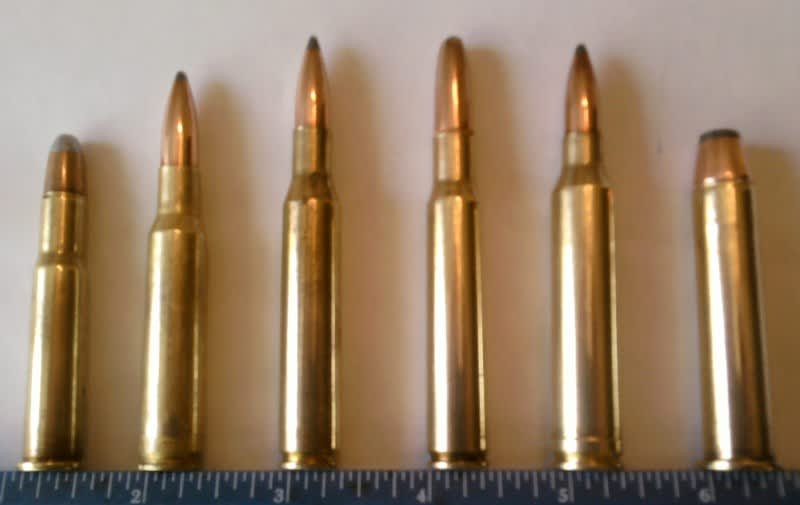The World’s Best Rifle Cartridge
Don Moyer 07.31.12

They say that the true test of another person’s intelligence is how much they agree with you. I was at a high school reunion the other day and ran into a classmate who is a fanatical hunter. I asked him what he considered the world’s best all-around rifle cartridge. Sure enough, old Butch’s answer concurred with mine. Old Butch is a pretty sharp old codger.
Trying to name the best rifle cartridge is sort of like asking, “How high is up?”. The answer depends on your perspective. Since the beginning of modern smokeless rifle cartridges in the late 19th century, there have been numerous cartridges that have been used and loved by riflemen around the world. All have pros and cons. It’s been claimed that the venerable .30-30 Winchester has taken more deer than any caliber in the world. I suspect that’s probably true, and if you’re a whitetail hunter in the woods of the eastern U.S. than you’d probably swear that the .30-30 is the world’s best cartridge.
However, if you’re a fan of hunting Rocky Mountain elk, you’d probably laugh at the puny .30-30 and be much more inclined to favor a 7mm Magnum or a .308 Winchester. Hunters seeking mule deer on the open reaches of the Great Basin may turn to the .270 Winchester as their choice for the best rifle, while antelope hunters in the same range may depend upon a .243. Professional guides in Alaska swear by a lever-action in .45-70 that will deliver massive stopping power on a charging Grizzly at 20 yards.
In short, your definition of the best cartridge will be influenced by the kind of game you hunt, as well as the terrain you hunt in. Varmint hunters prefer a cartridge that shoots a fairly light bullet at amazingly fast speeds. They’ll choose cartridges like .223 Remington, .25-06, .22 Hornet or something more esoteric like .257 Roberts. Varmint hunters need a cartridge that can cover a long distance in a very short time, and thus the slower, heavy bullets needed for bear, elk or moose are almost useless to them. By contrast, a varmint caliber might just make a bear or moose angry and could get you killed.
If I had to pick just one caliber to hunt the broadest array of North American game, I have no doubt that I’d choose the .30-06. As its name suggests, it’s been around for over 100 years and it’s available everywhere. You can find .30-06 ammo anywhere from fancy gun shops to small town hardware stores all over America. The .30-06 was born out of Teddy Roosevelt’s experiences in the Spanish-American War. While most folks have heard of the Battle of San Juan Hill, very few are aware that a small contingent of Spanish troops armed with the new Mauser rifles almost kicked our butts.
It took 19,000 troops to dislodge 800 Spaniards from San Juan Hill. The combined U.S. and Cuban forces suffered six times the casualty rate as the Spaniards. There were 1,385 U.S./Cuban casualties and only 228 Spanish casualties. In his memoirs, Roosevelt talks repeatedly about the clear superiority of the 7mm Mauser used by the Spaniards.
A few years later when he became President, Teddy Roosevelt ordered the U.S. Military to design a rifle that would out-perform the 7mm Mauser. After trying different designs, the U.S. Army adopted the .30 caliber cartridge of 1906 and the famous .30-06 was born. It was designed to be used in a Mauser-type bolt-action rifle with 3 locking lugs, the storied M1903 Springfield, an exceptionally resilient design that remains widely popular amongst collectors, hunters and target shooters to this day. Almost all modern bolt-actions are still based on the same 1898 Mauser action the M1903 Springfield used.
Millions of American G.I.s carried small arms chambered in .30-06 into the trenches of World War I and through the jungles and hedgerows of World War II. After they got home from their wars, American boys began getting the .30-06 for hunting as well. The .30-06 rifle cartridge can be found on almost every continent, including North and South America, Africa, Europe and Asia. While it is no longer issued for most armies of the world, the .30-06 is still used by sportsmen and women everywhere because of its versatility. You can get light bullets of 110 to 120 grains that travel at almost 4,000 feet per second. They are ideal in big open country for varmints and antelope. The medium weight 140 grain bullets still achieve speeds of over 2,500 feet per second and carry a lethal punch at several hundred yards for deer and black bear. The heavy duty 230 grain bullets are dynamite for tough critters like boar, grizzlies, and elk.
All of the other cartridges out there can be excellent for their intended purpose, but in my opinion, the .30-06 is the best all around rifle cartridge in the North America, if not all the world. If you disagree, contact me and tell me why. It might be an interesting discussion.

